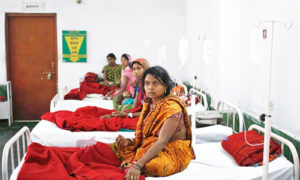India’s Family Planning Programme: Delivering Quality with Care
FP programme is still skewed towards female sterilization, thus, making it important to work towards expanding the basket of contraceptive choice and creating awareness about the same.
The government’s decadal report card on health and family welfare, or the National Family Health Survey, has shown significant improvements across indicators of health, education, and women’s empowerment. The achievements of family planning has been verified in the data factsheet of the fourth National Family Health Survey (NFHS IV), Total Fertility Rate (TFR) has declined by 0.5 to 2.2 in 2015-16 as compared to 2.7 in 2005-06.
 There are also other encouraging developments within the Family Planning (FP) program such as the introduction of three new contraceptive methods (Centchroman, Progestin-Only Pill and Injectable contraceptive) besides the launching of Mission Parivar Vikas, which seeks to ensure improved access to contraceptives and family planning services in 145 high focused districts in seven states.
There are also other encouraging developments within the Family Planning (FP) program such as the introduction of three new contraceptive methods (Centchroman, Progestin-Only Pill and Injectable contraceptive) besides the launching of Mission Parivar Vikas, which seeks to ensure improved access to contraceptives and family planning services in 145 high focused districts in seven states.
However, despite its evolution over the years, India’s family planning programme has been unable to imbibe key criterions that standardize the quality of care (QoC) of its services. The evidence lies in the indicators included in NFHS IV to measure QoC. Only 17.7 percent of health workers responded yes to the question ‘if a health worker ever talked to a female non-user about family planning’ and 46.5 percent of the current users were ever told about side effects of available methods. A large number of women are not being counseled on family planning or spacing methods, which explains the low use of contraceptive in the country as well.
Accurate information empowers people to choose a contraceptive method that suits them. Therefore, information on FP services should include awareness on the range of methods available, their advantages, side-effects and its impact on sexual and reproductive health.
Efforts towards improving the outcome of the above mentioned indicators will not only be crucial for ensuring reproductive rights and choices, but also to ensure the QoC standards in FP programmes. The adherence to QoC will necessarily address most of the concerns related to awareness, delivery of services on ground, ensure availability of products and also post service support through helplines. According to an article in the Indian Journal of Medical Research by Dr. Saroj Pachauri, improving the quality and reach of family planning services will also address the issue of unmet contraceptive need and accelerate fertility reduction and impact mortality.
What are the elements of QoC that we should strive for?
The components of an effective family planning programme and that of quality of care are not independent of each other. When deconstructed, QoC is to provide choice of method, information, technical competency, interpersonal relationships, follow ups and constellation of services.
Given that India’s FP programme is still skewed towards female sterilization, it is important to work towards expanding the basket of contraceptive choice and creating awareness for the same. With the introduction of three new methods, the government has taken the right step, although the availability of these products till the sub district level remains to be addressed. It now needs to focus on the provision of these methods at all levels.
Research indicates that the addition of one method leads to an average increase of 12 percent in contraceptive usage. For example in Bangladesh, household provision of injectable contraceptives in 1977 helped raise contraceptive prevalence from 7 to 20 percent. Evidence also suggests that, increased choice not only accelerates fertility decline, but also reduces maternal, neonatal and infant mortality.
However, the NFHS 4 data indicates that nearly half the women who have adopted a method were not informed about the side-effects by the frontline workers.
A fair understanding of interpersonal communication allows us to be acquainted with the client, their attitude, perceptions and feelings about the subject. It assists in conveying the right message and building a rapport with the client along with clearing the myths and misconceptions about the use of contraceptives. Further, engagement and participation of men within the ambit of interpersonal communication with women/partners on the issue can be a key to turning the tide in the country and cannot be underscored enough.
Studies reveal that men not only consider contraception as a women’s issue, but also often control their decision making on using contraception. In fact, NFHS III data reveals that 22 percent men feel that contraception is women’s business.
The issue of family planning cannot be divorced from other routine health services. Regular follow up with users are equally necessary to monitor the possibility of any complications. This can be achieved by establishing follow up mechanisms like scheduling appointments, home-visits etc.
Working together in partnership
It is crucial for the government to keep the momentum going to fulfil their global Family Planning commitments of reaching 48 million new users by 2020. And the need to strengthen infrastructure, human resource management, accountability and governance of the public health system has been repeatedly emphasised. A public private partnership (PPP) can help address these impediments, as seen in the example of Karuna Trust – a public health centre (PHC) that utilises the same resources as a government run PHC, but focuses on improving quality, access, and acceptability. Expansion of private-sector services will increase the outreach of India’s family planning programme and improve the quality of family planning services. However, the role of private sector in family planning is currently miniscule. Their skills, expertise and technology can be leveraged for improving the quality of care and scaling up of FP services.
